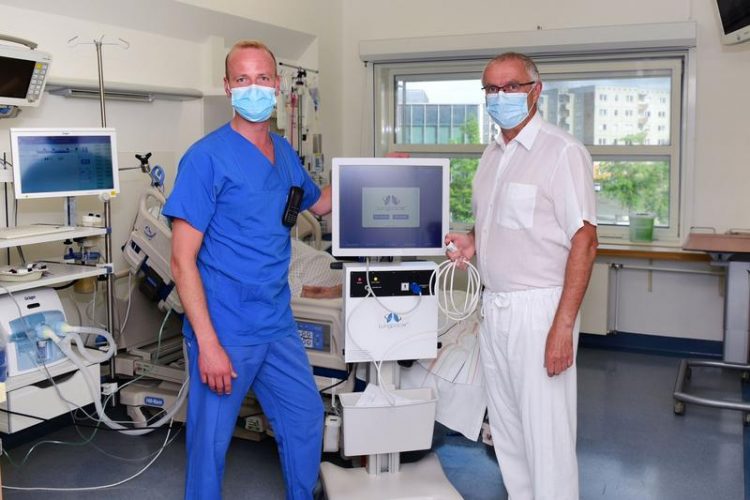First COVID-19 Patient in Germany successfully treated with novel Diaphragm Therapy

Professor Ralf Ewert (right) and respiratory therapist Franco Lemke with the new lungpacer system, from which further patients with mechanical ventilation should benefit. Photo: Manuela Janke/UMG
Department B for Internal Medicine of the University Medical Center Greifswald successfully used, within an international multi-center trial, a special diaphragmatic stimulation therapy to treat a COVID-19 patient as the first clinical site in Europe.
“The first patient treated in this trial happened to be a woman who survived COVID-19,
but was not able to be weaned from mechanical ventilation,” said Prof. Dr. Ralf
Ewert, the head of the Pneumology, Infection Disease and Weaning Centre at the University Medical School of Greifswald.
“With the new procedure, we were able to treat this patient, who is over 65 years old and has already spent 38 days on ventilator and enabled her return to independent breathing. In total we have now included four patients into the study and are pleased to contribute to this promising technology with our results,” says the Greifswald pneumologist and mechanical ventilation specialist.
The Lungpacer® System by Lungpacer Medical Inc., a Canadian medical device company, is a novel technology that stimulates the phrenic nerves during mechanical ventilation and thus
strengthens the weakened diaphragm muscle to assist in weaning from the ventilator.
The University Medicine Greifswald is the first hospital in Germany to participate in the so-called RESCUE-3 study, to provide safety and effectiveness data for the new procedure. In Germany, the system is currently only available as part of clinical studies.
Via strengthening the diaphragm back to life
During the COVID 19 pandemic, there are more patients in hospitals requiring
invasive mechanical ventilation over long periods of time. While mechanical ventilation is live-saving in the case of respiratory failure, it can also be harmful, especially if it is required over a longer period of time. Ventilators use positive pressure to push air into the lungs so that the main respiratory muscle, the diaphragm, is not used.
The diaphragm is a plate consisting of muscles and tendons that separates the chest from the abdomen. As a result, mechanical ventilation and artificial immobilization of the patient quickly leads to loss of diaphragmatic strength. This is what doctors refer to as Ventilator-Induced Diaphragmatic Dysfunction.
The Lungpacer® System is designed to be easily integrated into the routine care of patients with invasive mechanical ventilation. The system uses the LIVE catheter, which is similar to central venous catheters used in most ventilated patients.
The catheter can be used to inject fluids and medications and to stimulate the diaphragm and phrenic nerves to train the diaphragm muscle to assist in weaning.
The Lungpacer® Control Unit is a mobile, portable unit used with the catheter and intermediate cable to provide temporary diaphragmatic neurostimulation.
Background RESCUE-3 Study
The RESCUE-3 study, which started in 2019, is a randomized, controlled, open, multi-center adaptive clinical trial to investigate the safety and effectiveness of the Lungpacer® Diaphragm Pacing Therapy system for patients who have failed to wean from mechanical ventilation. Patients enrolled into the trial have failed two or more weaning attempts and stayed more than 96 hours (4 days) on mechanical ventilation. The study will enroll up to 376 subjects and will be conducted at up to 80 sites in the US, EU. Further information are available at http://www.lungpacer.com
Universitätsmedizin Greifswald
Klinik und Poliklinik für Innere Medizin B
Direktor: Prof. Dr. med. Stephan Felix
Ferdinand-Sauerbruch-Straße, 17475 Greifswald
T +49 3834 86-80 500
E InnereB@med.uni-greifswald.de
Studienleiter: Prof. Dr. Ralf Ewert
E ewert@uni-greifswald.de
T +49 3834 86-80 595
Pressesprecher Christian Arns
T +49 3834 86-52 28
E christian.arns@med.uni-greifswald.de
http://www.medizin.uni-greifswald.de
http://www.facebook.com/UnimedizinGreifswald
Instagram/Twitter @UMGreifswald
Studienleiter: Prof. Dr. Ralf Ewert
E ewert@uni-greifswald.de
T +49 3834 86-80 595
Media Contact
All latest news from the category: Medical Engineering
The development of medical equipment, products and technical procedures is characterized by high research and development costs in a variety of fields related to the study of human medicine.
innovations-report provides informative and stimulating reports and articles on topics ranging from imaging processes, cell and tissue techniques, optical techniques, implants, orthopedic aids, clinical and medical office equipment, dialysis systems and x-ray/radiation monitoring devices to endoscopy, ultrasound, surgical techniques, and dental materials.
Newest articles

Pinpointing hydrogen isotopes in titanium hydride nanofilms
Although it is the smallest and lightest atom, hydrogen can have a big impact by infiltrating other materials and affecting their properties, such as superconductivity and metal-insulator-transitions. Now, researchers from…

A new way of entangling light and sound
For a wide variety of emerging quantum technologies, such as secure quantum communications and quantum computing, quantum entanglement is a prerequisite. Scientists at the Max-Planck-Institute for the Science of Light…

Telescope for NASA’s Roman Mission complete, delivered to Goddard
NASA’s Nancy Grace Roman Space Telescope is one giant step closer to unlocking the mysteries of the universe. The mission has now received its final major delivery: the Optical Telescope…



